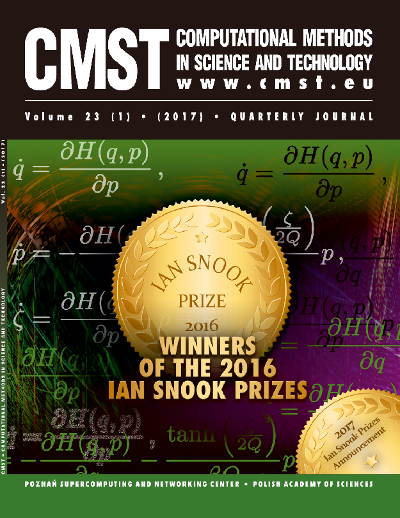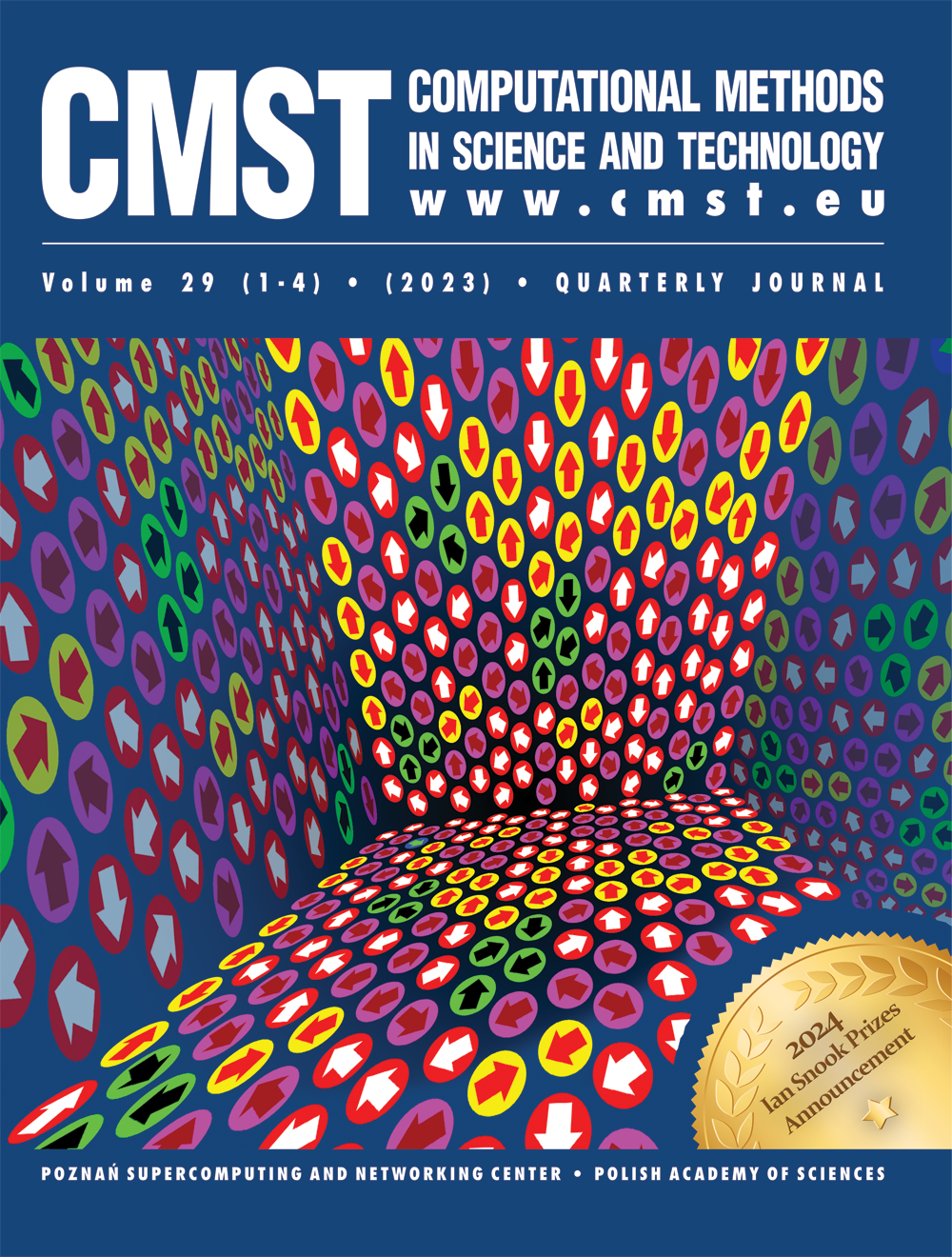CONCEPT OF A FORMAL SYSTEM AIMED AT MODELLING BIOLOGICAL PROCESSES IN CELL
Institute of Fluid-Flow Machinery, Polish Academy of Sciences,
J. Fiszera 14, 80-952 Gdańsk, Poland
Received:
Received 19 February 2001
DOI: 10.12921/cmst.2002.08.01.31-62
OAI: oai:lib.psnc.pl:527
Abstract:
In this paper a concept of a formal system aimed at modelling biological processes in cell is introduced. The aim of this formulation is to provide a theoretical basis for numerical simulations of the biological processes taking into account accessibility to various levels of details and possible full complexity of phenomena associated with them. The main segment of this formal system is a method of multiscale modelling called here the collection of dynamical systems with dimensional reduction. This approach allows one to integrate various mathematical methods applied in cell biology. It is especially related to continuum mechanics and molecular dynamics. Such a formal mathematical approach is supplemented by a set of notions which characterizes specific properties of biological systems. They are: the molecular recognition, integrity property for a chain of chemical reactions and molecular reactive structures. Nanoscale models of molecules are suggested to be a central segment of the multiscale modelling and are designed to direct cooperation with molecular dynamics. They are aimed at describing multimolecular processes in cell. It is shown that the nanoscale level of description is convenient for modelling molecular motors. Status of the present stage of formulation of the formal system is discussed taking into account further development directions.
References:
[1] G. F. Oster, G. M. Odell, The mechanochemistry ofcytogels, Physica 12D, 333-350 (1984).
[2] R. Elber, M. Karpulus, Multiple conformational states of proteins: A molecular dynamics analysis of myoglobin, Science 235, 318-321 (1987).
[3] M. E. Tuckerman, G. J. Martyna, Understanding modern molecular dynamics: techniques and applications, J. Phys. Chem. 104, 159-178 (2000).
[4] C. Truesdell, A first course in rational continuum mechanics, Baltimore, Maryland 1972.
[5] H. Haken, Synergetics, Springer Verlag, Berlin, Heidelberg, New York 1977.
[6] C. Truesdell, W. Noll, The non-linear field theories of mechanics, Handbuch der Physik III/3,
S.Flúgge (ed.), Springer 1965.
[7] W. G. Hoover, Molecular dynamics, Lecture Notes in Physics 258, Springer Verlag 1986.
[8] G. Cicotti, W. G. Hoover, Molecular dynamics simulations of statistical mechanical systems, Proc. of the Int. School of Phys. Enrico Fermi 1986.
[9] M. Parinello, A. Rahman, Polymorphic transitions in single crystals: A new molecular dynamics method, J. Appi. Phys. 52, 12, 7182-7190 (1981).
[10] J-M. Lehn, Supramolecular chemistiy — scope and perspectives, molecules, supra-molecules, and molecular devices, Angew. Chem., Int. Ed. Engl. 27, 89-112 (1988).
[11] J. Kaczmarek, Chemical recognition dynamics as a theoretical approach to chemical synthesis. Bull, of the Polish Academy of Sciences, Techn. Sci. 48, 12-27 (2000).
[12] P. E. Smith, B. M. Pettitt, Modelling solvent in biomolecidar systems, J. Phys. Chem. 98,
9700-9711 (1994).
[13] W. Kołos, Quantum chemistry, PWN, Warszawa 1978.
[14] P. G. Mezey, Potential energy hypersurface, Eisner Science Publishers B.V., 1987.
[15] P. G. Mezey, Catchment region partitioning of energy hypersurface, Theor. Chim. Acta (Berl..) 58, 309-330 (1981).
[16] M. C. Beckerle, Spatial control ofactin filament assembly: Lessons from listeria, Cell 95, 741-748 (1998).
[17] A. Hall, Rho GTPases and the actin cytoskeleton. Science 279, 509-514 (1998).
[18] K. E. Prehoda, D. J. Lee, W. A. Lira, Structure of the Enabled/VASP homology 1, domain-peptide complex: A key component in the spatial control of actin assembly, Cell 97, 471-480 (1999).
[19] W. R. Rudnicki, G. Bakalai’ski, B. Lesyng, A mezoscopic model of nucleic acids. Part 1.
Lagrangean and quaternion molecular dynamics, J. Biomol. Str. and Dyn. 17/6, 1097-1108, (2000).
[20] C. von Westenholtz, Differential forms in mathematical physics, North- Holland 1981.
[21] J. Kaczmarek, A method of integration of molecular dynamics and continuum mechanics for solids, TASK Quaterly 6/2, 253-271 (2002).
[22] P. K. Bhatia, Z. Wang, E. C. Fredberg, DNA repair and transcription, Curr. Opin. in Gen. and Dev., 6, 146-150(1996).
[23] N. Hirokawa, Kinesin and dynein superfamily proteins and the mechanism of organelle transport, Science 279, 519-526 (1998).
[24] j. Gelles, R. Landick, RNA polymerase as a molecular motor, Cell 93, 13-16 (1998).
[25] K. Kinosita, Jr., R. Yasuda, H. Noji, S. Ishiwata, M. Yoshida, F1-ATPase: A rotary motor made of a single molecule, Cell, 93, 21-24, 1998.
[26] F. Jülicher, A. Ajdari, J. Prost, Modelling molecular motors, Rev. Mod. Phys. 69, 1269-1281
(1997).
[27] C. R. Doering, W. Horsthemke, J. Riordan, Nonequilibrium fluctuation-induced transport, Phys. Rev. Lett. 72, 2984-2987 (1994).
[28] R. D. Astumian, M. Bier, Fluctuation Driven Ratchets: Molecular motors, Phys. Rev. Lett., 72, 1766-1769(1994).
[29] K. Abel, F. Jurnak, A complex profile of protein elongation: translating chemical energy into molecular movement, Structure 4, 229-238 (1996).
In this paper a concept of a formal system aimed at modelling biological processes in cell is introduced. The aim of this formulation is to provide a theoretical basis for numerical simulations of the biological processes taking into account accessibility to various levels of details and possible full complexity of phenomena associated with them. The main segment of this formal system is a method of multiscale modelling called here the collection of dynamical systems with dimensional reduction. This approach allows one to integrate various mathematical methods applied in cell biology. It is especially related to continuum mechanics and molecular dynamics. Such a formal mathematical approach is supplemented by a set of notions which characterizes specific properties of biological systems. They are: the molecular recognition, integrity property for a chain of chemical reactions and molecular reactive structures. Nanoscale models of molecules are suggested to be a central segment of the multiscale modelling and are designed to direct cooperation with molecular dynamics. They are aimed at describing multimolecular processes in cell. It is shown that the nanoscale level of description is convenient for modelling molecular motors. Status of the present stage of formulation of the formal system is discussed taking into account further development directions.
[1] G. F. Oster, G. M. Odell, The mechanochemistry ofcytogels, Physica 12D, 333-350 (1984).
[2] R. Elber, M. Karpulus, Multiple conformational states of proteins: A molecular dynamics analysis of myoglobin, Science 235, 318-321 (1987).
[3] M. E. Tuckerman, G. J. Martyna, Understanding modern molecular dynamics: techniques and applications, J. Phys. Chem. 104, 159-178 (2000).
[4] C. Truesdell, A first course in rational continuum mechanics, Baltimore, Maryland 1972.
[5] H. Haken, Synergetics, Springer Verlag, Berlin, Heidelberg, New York 1977.
[6] C. Truesdell, W. Noll, The non-linear field theories of mechanics, Handbuch der Physik III/3,
S.Flúgge (ed.), Springer 1965.
[7] W. G. Hoover, Molecular dynamics, Lecture Notes in Physics 258, Springer Verlag 1986.
[8] G. Cicotti, W. G. Hoover, Molecular dynamics simulations of statistical mechanical systems, Proc. of the Int. School of Phys. Enrico Fermi 1986.
[9] M. Parinello, A. Rahman, Polymorphic transitions in single crystals: A new molecular dynamics method, J. Appi. Phys. 52, 12, 7182-7190 (1981).
[10] J-M. Lehn, Supramolecular chemistiy — scope and perspectives, molecules, supra-molecules, and molecular devices, Angew. Chem., Int. Ed. Engl. 27, 89-112 (1988).
[11] J. Kaczmarek, Chemical recognition dynamics as a theoretical approach to chemical synthesis. Bull, of the Polish Academy of Sciences, Techn. Sci. 48, 12-27 (2000).
[12] P. E. Smith, B. M. Pettitt, Modelling solvent in biomolecidar systems, J. Phys. Chem. 98,
9700-9711 (1994).
[13] W. Kołos, Quantum chemistry, PWN, Warszawa 1978.
[14] P. G. Mezey, Potential energy hypersurface, Eisner Science Publishers B.V., 1987.
[15] P. G. Mezey, Catchment region partitioning of energy hypersurface, Theor. Chim. Acta (Berl..) 58, 309-330 (1981).
[16] M. C. Beckerle, Spatial control ofactin filament assembly: Lessons from listeria, Cell 95, 741-748 (1998).
[17] A. Hall, Rho GTPases and the actin cytoskeleton. Science 279, 509-514 (1998).
[18] K. E. Prehoda, D. J. Lee, W. A. Lira, Structure of the Enabled/VASP homology 1, domain-peptide complex: A key component in the spatial control of actin assembly, Cell 97, 471-480 (1999).
[19] W. R. Rudnicki, G. Bakalai’ski, B. Lesyng, A mezoscopic model of nucleic acids. Part 1.
Lagrangean and quaternion molecular dynamics, J. Biomol. Str. and Dyn. 17/6, 1097-1108, (2000).
[20] C. von Westenholtz, Differential forms in mathematical physics, North- Holland 1981.
[21] J. Kaczmarek, A method of integration of molecular dynamics and continuum mechanics for solids, TASK Quaterly 6/2, 253-271 (2002).
[22] P. K. Bhatia, Z. Wang, E. C. Fredberg, DNA repair and transcription, Curr. Opin. in Gen. and Dev., 6, 146-150(1996).
[23] N. Hirokawa, Kinesin and dynein superfamily proteins and the mechanism of organelle transport, Science 279, 519-526 (1998).
[24] j. Gelles, R. Landick, RNA polymerase as a molecular motor, Cell 93, 13-16 (1998).
[25] K. Kinosita, Jr., R. Yasuda, H. Noji, S. Ishiwata, M. Yoshida, F1-ATPase: A rotary motor made of a single molecule, Cell, 93, 21-24, 1998.
[26] F. Jülicher, A. Ajdari, J. Prost, Modelling molecular motors, Rev. Mod. Phys. 69, 1269-1281
(1997).
[27] C. R. Doering, W. Horsthemke, J. Riordan, Nonequilibrium fluctuation-induced transport, Phys. Rev. Lett. 72, 2984-2987 (1994).
[28] R. D. Astumian, M. Bier, Fluctuation Driven Ratchets: Molecular motors, Phys. Rev. Lett., 72, 1766-1769(1994).
[29] K. Abel, F. Jurnak, A complex profile of protein elongation: translating chemical energy into molecular movement, Structure 4, 229-238 (1996).



